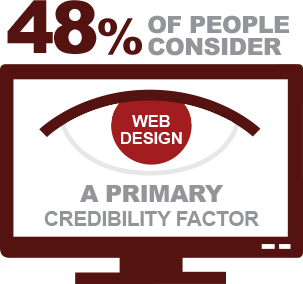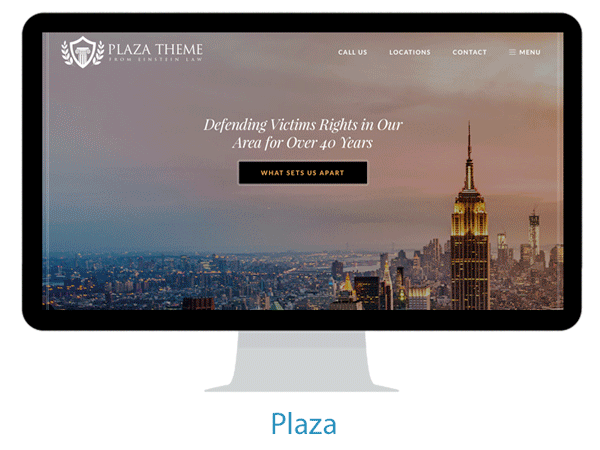Form & Function in Website Design: The Art of Persuasion for Attorneys
When you’re in front of a jury, success hinges not only on the facts of your case, but how they are presented.
The same obstacles confront you online when it comes time to “present your case” to potential clients. Except in the land of Google, you aren’t face-to-face with your audience. Here, your website is your front man.
And online, just as in the courtroom, presentation matters. It's not just "what" you say, it's "how" you say it. In a word, it's all about "design."
But don't make the mistake of thinking that your website's design is the digital equivalent of a pretty picture.
“Most people make the mistake of thinking design is what it looks like. People think it’s this veneer – that the designers are handed this box and told, ‘Make it look good!’ That’s not what we think design is. It’s not just what it looks like and feels like.
"Design is how it works.” – Steve Jobs
Is your website unattractive? Is it clunky? Is it confusing? Each faux pas undercuts your perceived value and nibbles away at your credibility. Building trust starts with a website that offers an optimum experience in both form and function. Afterall, pretty is as pretty does.

Judgments come swift and sure online. In the blink of an eye, people make conscious and subconscious judgments about your website and, by extension, you.
And, if you are hoping to hold someone’s attention in this digital dogpile of distractions, think quick. Nowadays, humans' attention span is shorter than a goldfish's.
To overcome these obstacles, your website needs to meld form and function. The medium is the message.
The Hallmarks of Good Design
Good website design caters to the user, and here's where simplicity triumphs.
Just as your computer slows down when too many programs are open, so does the human brain. Inundated with too much information or a confusing format, people become overwhelmed. Then, when they max out, they leave.
A simple, clean design reduces the cognitive load — the mental effort — required to understand how to use a website or what it's trying to say.

Everything should be made as simple as possible, but not simpler.
— Albert Einstein
Well-designed websites reduce the cognitive load by giving people the information they need — but not until they need it.
The trick is discovering the right mix of form and function that resonates with your visitors, your potential clients.
But there’s a “gotcha.” You can't rely solely on logic to understand what your site's visitors want because, frankly, people aren't always logical.
They fail to make optimal choices on websites because they are prone to "satisficing," opting for choices that are "'good enough." Sometimes those choices are simply blind guesses because the mental effort required to understand a confusing website has exhausted their patience. At other times they just leave.
So if logic isn't the Holy Grail of web design, then what is? Data.
Data-Driven Design
When people say one thing and do another, then data is where the truth lies. With more than 20 years of data tracking visitor behavior on websites, Einstein Law draws on a wealth of knowledge — not just hunches — to design websites that help turn online visitors into in-office consultations.
With a treasure trove of digital body language, we are uniquely positioned to draw statistically significant conclusions about the best ways to convince prospective clients to take the next step and connect.
Then we act on those conclusions to design websites that don’t just “look smart,” but also convert website visitors. The process has allowed us to introduce a new class of data-driven designs that blend form and function, catering to the dual need for websites to please both search engines and people alike.
Responsive Website Designs
Traits of Good Design
- Less is more. Studies show that users prefer websites with lower visual complexity. A simple design allows you to focus visitors’ attention right where you want it: On the message. Because our data shows that 50% of all pageviews are for four specific pages or sections of a site, we've simplified navigation to ensure the most popular items stand out.
- Embrace white space. Don't fill every nook and cranny with "stuff." White space allows you to direct a viewer's attention. White space also imparts an expansive feeling, which equates with quality. There's a reason advertising for luxury products takes this minimalist approach.
- Create a visual hierarchy. Users don't read, they scan the page looking for a likely landing spot. By using color, typography, or imagery you can help them on their journey with visual clues that guide them to their goal. Visual hierarchy makes the next step obvious. No thinking required.
- Make it a Lamborghini. Make it fast. In the online world, statistics show that speed wins. Web users insist on instant gratification, even when they are hamstrung by limited bandwidth on a mobile phone. Speed is also a boon when it comes to pleasing Google, which uses website speed as a ranking factor.
- Play by the rules. Websites should be original, but at the same time conventional. This is no time to force your visitors into a game of "Where's Waldo?" The standard parts of a website, such as logos and navigation, should be placed where people expect to find them so you don’t irritate visitors. Imagine reading a magazine that flouted convention and put the table of contents in the back.
- Easy to navigate. Visitors should intuitively understand the structure of your website and where to find information. On mobile, buttons and links should be large enough and spaced so users can avoid fat-finger typing mistakes.
- Impressive at any size. As your brand ambassador, your website needs to look good on mobile, tablet, and desktop. Research shows that people make judgments about staying or leaving within milliseconds of arriving on a website.
Designing For Micro-Moments
In today's multi-device world, design has to overcome more hurdles than ever. As consumers jump from mobile to laptop in a journey that has been fractured into micro-moments, design has to keep pace by offering an optimum experience on every device.
Don't be lulled into complacency by assuming the journey for important decisions happens only on desktops.
- Today's consumer takes advantage of micro-moments, fragmenting research into a multi-step process on multiple devices. Even though the odds are they will eventually gravitate to a laptop for in-depth research, you still want to introduce yourself early in the journey, which statistics show most likely will be on a mobile device.
- Even brief visits from a mobile device should not be discounted because first impressions are lasting ones. Each micro-moment is an opportunity to shape a prospective client’s journey. If you think mobile doesn't matter then you could be missing out on the longer pre-journey that builds trust and credibility.
- Be present at all stages of the journey to improve your chances of landing on a potential client’s short list of practices that they will call for a consultation.
In our tech-tethered society, you won't know when a micro-moment will happen. And you don't know where. But if your website embraces both form and function, you'll be putting your best foot forward whenever, wherever it happens.
Responsive Legal Websites





